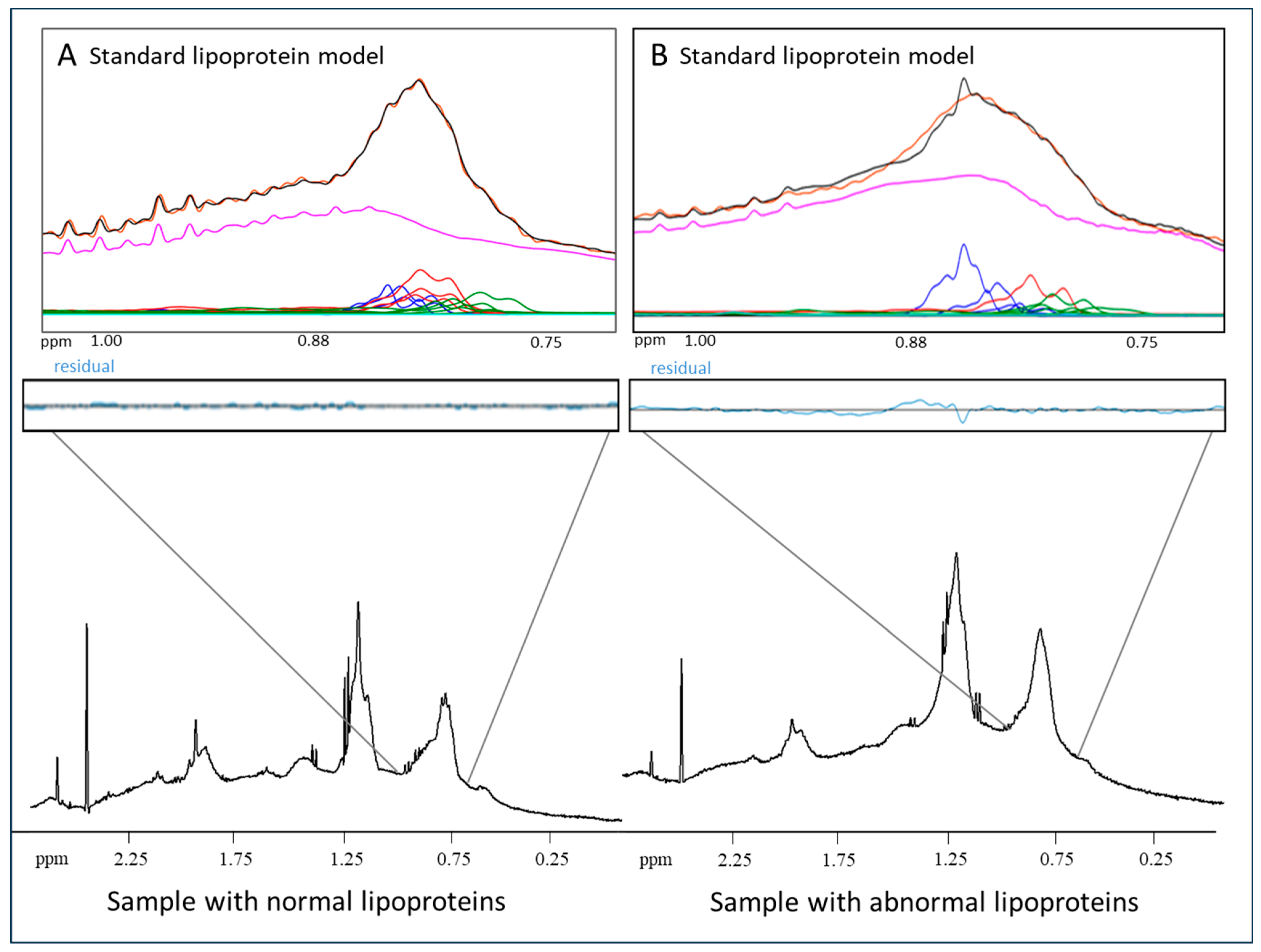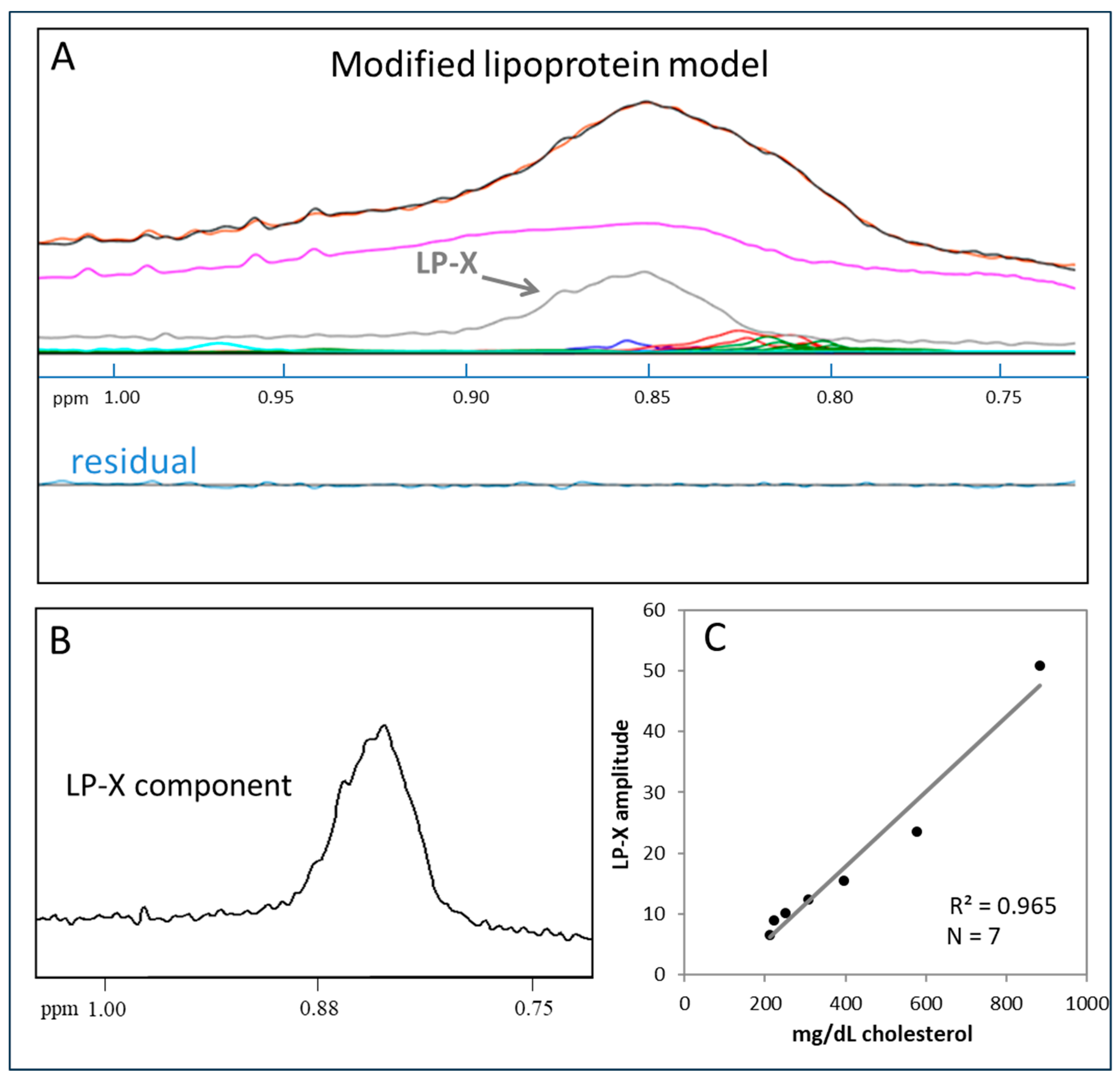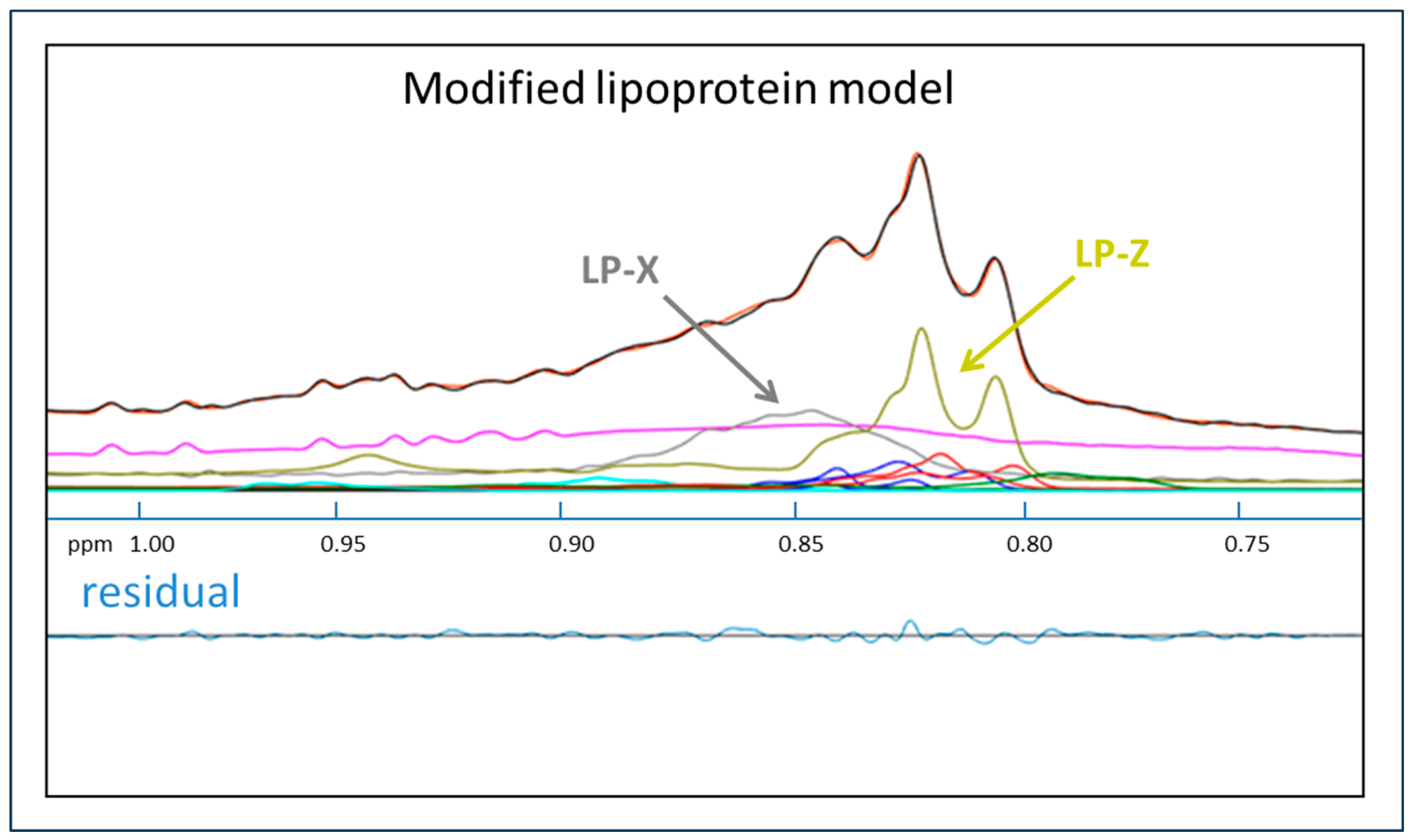A High-Throughput NMR Method for Lipoprotein-X Quantification
Abstract
1. Introduction
2. Results
2.1. Quantification of LP-X
2.2. Assay Performance
2.3. Stability and Substance Interference Testing
2.4. Simultaneous Quantification of LP-X and LP-Z
2.5. LP-X Disease Associations
3. Discussion
4. Materials and Methods
4.1. Synthetic LP-X and Natural LP-X from High Bilirubin Samples
4.2. Explanation of Deconvolution Models
4.3. NMR Data Acquisition
4.4. LP-X Quantification by Deconvolution
4.5. Assay Analytical Performance: Imprecision, Sensitivity, and Linearity
4.6. Stability (Refrigerated, Freeze–Thaw)
4.7. In Vitro Test for Interfering Substances
4.8. LP-X Disease Associations
5. Conclusions
6. Patents
Author Contributions
Funding
Institutional Review Board Statements
Informed Consent Statement
Data Availability Statement
Conflicts of Interest
References
- Seidel, D.; Alaupovic, P.; Furman, R.H. A lipoprotein characterizing obstructive jaundice. I. Method for quantitative separation and identification of lipoproteins in jaundiced subjects. J. Clin. Investig. 1969, 48, 1211–1223. [Google Scholar] [CrossRef] [PubMed]
- Kostner, G.M.; Laggner, P.; Prexl, H.J.; Holasek, A. Investigation of the abnormal low-density lipoproteins occurring in patients with obstructive jaundice. Biochem. J. 1976, 157, 401–407. [Google Scholar] [CrossRef] [PubMed]
- Patsch, J.R.; Aune, K.C.; Gotto, A.M., Jr.; Morrisett, J.D. Isolation, chemical characterization, and biophysical properties of three different abnormal lipoproteins: LP-X1, LP-X2, and LP-X3. J. Biol. Chem. 1977, 252, 2113–2120. [Google Scholar] [CrossRef] [PubMed]
- Laggner, P.; Glatter, O.; Muller, K.; Kratky, O.; Kostner, G.; Holasek, A. The lipid bilayer structure of the abnormal human plasma lipoprotein X. An X-ray small-angle-scattering study. Eur. J. Biochem. 1977, 77, 165–171. [Google Scholar] [CrossRef]
- Miller, J.P. Dyslipoproteinaemia of liver disease. Bailliere’s Clin. Endocrinol. Metab. 1990, 4, 807–832. [Google Scholar] [CrossRef] [PubMed]
- Agorastos, J.; Fox, C.; Harry, D.S.; McIntyre, N. Lecithin-cholesterol acyltransferase and the lipoprotein abnormalities of obstructive jaundice. Clin. Sci. Mol. Med. 1978, 54, 369–379. [Google Scholar] [CrossRef]
- Hamilton, R.L.; Havel, R.J.; Kane, J.P.; Blaurock, A.E.; Sata, T. Cholestasis: Lamellar structure of the abnormal human serum lipoprotein. Science 1971, 172, 475–478. [Google Scholar] [CrossRef]
- Crook, M.A. Lipoprotein X: Clinical implications. Ann. Clin. Biochem. 2013, 50, 93–94. [Google Scholar] [CrossRef]
- Utermann, G.; Schoenborn, W.; Langer, K.H.; Dieker, P. Lipoproteins in LCAT-deficiency. Humangenetik 1972, 16, 295–306. [Google Scholar] [CrossRef]
- Torsvik, H.; Berg, K.; Magnani, H.N.; McConathy, W.J.; Alaupovic, P.; Gjone, E. Identification of the abnormal cholestatic lipoprotein (LP-X) in familial lecithin: Cholesterol acyltransferase deficiency. FEBS Lett. 1972, 24, 165–168. [Google Scholar] [CrossRef]
- Ritland, S.; Gjone, E. Quantitative studies of lipoprotein-X in familial lecithin: Cholesterol acyltransferase deficiency and during cholesterol esterification. Clin. Chim. Acta 1975, 59, 109–119. [Google Scholar] [CrossRef] [PubMed]
- Guerin, M.; Dolphin, P.J.; Chapman, M.J. Familial lecithin: Cholesterol acyltransferase deficiency: Further resolution of lipoprotein particle heterogeneity in the low density interval. Atherosclerosis 1993, 104, 195–212. [Google Scholar] [CrossRef] [PubMed]
- Dobiasova, M.; Frohlich, J.J. Advances in understanding of the role of lecithin cholesterol acyltransferase (LCAT) in cholesterol transport. Clin. Chim. Acta 1999, 286, 257–271. [Google Scholar] [CrossRef] [PubMed]
- Calabresi, L.; Simonelli, S.; Gomaraschi, M.; Franceschini, G. Genetic lecithin: Cholesterol acyltransferase deficiency and cardiovascular disease. Atherosclerosis 2012, 222, 299–306. [Google Scholar] [CrossRef]
- Frohlich, J.; McLeod, R.; Hon, K. Lecithin: Cholesterol acyl transferase (LCAT). Clin. Biochem. 1982, 15, 269–278. [Google Scholar] [CrossRef]
- Gjone, E.; Skarbovik, A.J.; Blomhoff, J.P.; Teisberg, P. Familial lecithin: Cholesterol acyltransferase deficiency. Report of a third Norwegian family with two afflicted members. Scand. J. Clin. Lab. Investig. Suppl. 1974, 137, 101–105. [Google Scholar] [CrossRef]
- Imbasciati, E.; Paties, C.; Scarpioni, L.; Mihatsch, M.J. Renal lesions in familial lecithin-cholesterol acyltransferase deficiency. Ultrastructural heterogeneity of glomerular changes. Am. J. Nephrol. 1986, 6, 66–70. [Google Scholar] [CrossRef]
- Foley, K.F.; Silveira, M.G.; Hornseth, J.M.; Lindor, K.D.; McConnell, J.P. A patient with primary biliary cirrhosis and elevated LDL cholesterol. Clin. Chem. 2009, 55, 187–191, disscusion 191–182. [Google Scholar] [CrossRef]
- Sorokin, A.; Brown, J.L.; Thompson, P.D. Primary biliary cirrhosis, hyperlipidemia, and atherosclerotic risk: A systematic review. Atherosclerosis 2007, 194, 293–299. [Google Scholar] [CrossRef]
- Rao, N.J.A.; Goyale, A.; Persaud, J.W.; Al-Musalhi, K.; Nair, D.R. Lipoprotein X in autoimmune liver disease causing interference in routine and specialist biochemical investigations. Clin. Lipidol. 2017, 12, 8–13. [Google Scholar]
- Brandt, E.J.; Regnier, S.M.; Leung, E.K.; Chou, S.H.; Baron, B.W.; Te, H.S.; Davidson, M.H.; Sargis, R.M. Management of lipoprotein X and its complications in a patient with primary sclerosing cholangitis. Clin. Lipidol. 2015, 10, 305–312. [Google Scholar] [CrossRef] [PubMed]
- Turchin, A.; Wiebe, D.A.; Seely, E.W.; Graham, T.; Longo, W.; Soiffer, R. Severe hypercholesterolemia mediated by lipoprotein X in patients with chronic graft-versus-host disease of the liver. Bone Marrow Transplant. 2005, 35, 85–89. [Google Scholar] [CrossRef] [PubMed][Green Version]
- Johnson, P.; Olegard, R.; Samsioe, G.; Gustafson, A. Studies in cholestasis of pregnancy. III. Fatty acid composition of serum phosphoglycerides. Acta Obstet. Gynecol. Scand. 1975, 54, 241–246. [Google Scholar] [CrossRef] [PubMed]
- Tashiro, T.; Mashima, Y.; Yamamori, H.; Sanada, M.; Nishizawa, M.; Okui, K. Intravenous intralipid 10% vs. 20%, hyperlipidemia, and increase in lipoprotein X in humans. Nutrition 1992, 8, 155–160. [Google Scholar] [PubMed]
- Griffin, E.; Breckenridge, W.C.; Kuksis, A.; Bryan, M.H.; Angel, A. Appearance and characterization of lipoprotein X during continuous intralipid infusions in the neonate. J. Clin. Investig. 1979, 64, 1703–1712. [Google Scholar] [CrossRef] [PubMed]
- Heimerl, S.; Boettcher, A.; Kaul, H.; Liebisch, G. Lipid profiling of lipoprotein X: Implications for dyslipidemia in cholestasis. Biochim. Biophys. Acta 2016, 1861, 681–687. [Google Scholar] [CrossRef] [PubMed]
- Suzuki, L.; Hirayama, S.; Fukui, M.; Sasaki, M.; Hiroi, S.; Ayaori, M.; Terai, S.; Tozuka, M.; Watada, H.; Miida, T. Lipoprotein-X in cholestatic patients causes xanthomas and promotes foam cell formation in human macrophages. J. Clin. Lipidol. 2017, 11, 110–118. [Google Scholar] [CrossRef] [PubMed]
- Shotwell, M.K.; Vorla, M.; Kalra, D.K. Very High Cholesterol Mimicking Homozygous Familial Hypercholesterolemia. Circulation 2022, 146, 1182–1188. [Google Scholar] [CrossRef]
- Talafant, E.; Tovarek, J. Turbidimetric determination of lipoprotein-X in serum. Clin. Chim. Acta 1979, 96, 261–264. [Google Scholar] [CrossRef]
- Seidel, D.; Wieland, H.; Ruppert, C. Improved techniques for assessment of plasma lipoprotein patterns. I. Precipitation in gels after electrophoresis with polyanionic compounds. Clin. Chem. 1973, 19, 737–739. [Google Scholar] [CrossRef]
- Hashiguchi, Y.; Kawaguchi, M.; Nakanishi, M.; Matsumori, Y.; Kaneda, Y.; Nakai, C.; Mimura, K.; Matsuoka, A. Simple, direct measurement of lipoprotein X in serum. Clin. Chem. 1982, 28, 606–608. [Google Scholar] [CrossRef] [PubMed]
- Neubeck, W.; Seidel, D. Direct method for measuring lipoprotein-X in serum. Clin. Chem. 1975, 21, 853–856. [Google Scholar] [CrossRef] [PubMed]
- Kostner, G.M.; Petek, W.; Holasek, A. Immunochemical measurement of lipoprotein-X. Clin. Chem. 1974, 20, 676–681. [Google Scholar] [CrossRef] [PubMed]
- Freeman, L.A.; Shamburek, R.D.; Sampson, M.L.; Neufeld, E.B.; Sato, M.; Karathanasis, S.K.; Remaley, A.T. Plasma lipoprotein-X quantification on filipin-stained gels: Monitoring recombinant LCAT treatment ex vivo. J. Lipid Res. 2019, 60, 1050–1057. [Google Scholar] [CrossRef] [PubMed]
- Neufeld, E.B.; Freeman, L.A.; Durbhakula, V.; Sampson, M.L.; Shamburek, R.D.; Karathanasis, S.K.; Remaley, A.T. A Simple Fluorescent Cholesterol Labeling Method to Cryoprotect and Detect Plasma Lipoprotein-X. Biology 2022, 11, 1248. [Google Scholar] [CrossRef] [PubMed]
- Neely, R.D.G.; Boot, C.S. Laboratory investigation of lipoprotein X. Clinical Lipidol. 2017, 12, 43–44. [Google Scholar]
- Brainard, J.R.; Cordes, E.H.; Gotto, A.M., Jr.; Patsch, J.R.; Morrisett, J.D. Lipoprotein-X: Proton and phosphorus-31 nuclear magnetic resonance studies on native, reconstituted, and model systems. Biochemistry 1980, 19, 4273–4279. [Google Scholar] [CrossRef]
- Brainard, J.R.; Hamilton, J.A.; Cordes, E.H.; Patsch, J.R.; Gotto, A.M., Jr.; Morrisett, J.D. Lipoprotein-X: Carbon-13 nuclear magnetic resonance studies on native, reconstituted, and model systems. Biochemistry 1980, 19, 4266–4273. [Google Scholar] [CrossRef]
- Parmar, Y.I.; Sparks, D.L.; Frohlich, J.; Cullis, P.R.; Pritchard, P.H. Detection of vesicular lipoproteins in lecithin: Cholesterol acyltransferase-deficient plasma by 1H-NMR spectroscopy. J. Lipid Res. 1989, 30, 765–771. [Google Scholar] [CrossRef]
- Matyus, S.P.; Braun, P.J.; Wolak-Dinsmore, J.; Jeyarajah, E.J.; Shalaurova, I.; Xu, Y.; Warner, S.M.; Clement, T.S.; Connelly, M.A.; Fischer, T.J. NMR measurement of LDL particle number using the Vantera Clinical Analyzer. Clin. Biochem. 2014, 47, 203–210. [Google Scholar] [CrossRef]
- Ossoli, A.; Neufeld, E.B.; Thacker, S.G.; Vaisman, B.; Pryor, M.; Freeman, L.A.; Brantner, C.A.; Baranova, I.; Francone, N.O.; Demosky, S.J., Jr.; et al. Lipoprotein X Causes Renal Disease in LCAT Deficiency. PLoS ONE 2016, 11, e0150083. [Google Scholar] [CrossRef]
- Bedi, S.; Garcia, E.; Jeyarajah, E.J.; Shalaurova, I.; Perez-Matos, M.C.; Jiang, Z.G.; Dullaart, R.P.F.; Matyus, S.P.; Kirk, W.J.; Otvos, J.D.; et al. Characterization of LP-Z Lipoprotein Particles and Quantification in Subjects with Liver Disease Using a Newly Developed NMR-Based Assay. J. Clin. Med. 2020, 9, 2915. [Google Scholar] [CrossRef] [PubMed]
- Melmed, S.; Polonsky, K.S.; Larsen, P.R.; Kronenberg, H.M. Chapter 37—Disorders of Lipid Metabolism. In Williams Textbook of Endocrinology, 13th ed.; Elsevier: Amsterdam, The Netherlands, 2016; pp. 1660–1700. [Google Scholar]
- Freeman, M.; Kuiken, L.; Ragland, J.B.; Sabesin, S.M. Hepatic triglyceride lipase deficiency in liver disease. Lipids 1977, 12, 443–445. [Google Scholar] [CrossRef] [PubMed]
- Vo, H.; Gosmanov, A.R.; Garcia-Rosell, M.; Wall, B.M. Pseudohyponatremia in acute liver disease. Am. J. Med. Sci. 2013, 345, 62–64. [Google Scholar] [CrossRef] [PubMed]
- Sivakumar, T.; Chaidarun, S.; Lee, H.K.; Cervinski, M.; Comi, R. Multiple lipoprotein and electrolyte laboratory artifacts caused by lipoprotein X in obstructive biliary cholestasis secondary to pancreatic cancer. J. Clin. Lipidol. 2011, 5, 324–328. [Google Scholar] [CrossRef] [PubMed]
- Herzum, I.; Giehl, C.; Soufi, M.; Junclas, H.; Wahl, H.G. Interference in a homogeneous assay for low-density lipoprotein cholesterol by lipoprotein X. Clin. Chem. Lab. Med. 2007, 45, 667–671. [Google Scholar] [CrossRef]
- Matsushima, K.; Sugiuchi, H.; Anraku, K.; Nishimura, H.; Manabe, M.; Ikeda, K.; Ando, Y.; Kondo, Y.; Ishitsuka, Y.; Irikura, M.; et al. Differences in reaction specificity toward lipoprotein X and abnormal LDL among 6 homogeneous assays for LDL-cholesterol. Clin. Chim. Acta 2015, 439, 29–37. [Google Scholar] [CrossRef]
- Fei, H.; Maeda, S.; Kirii, H.; Fujigaki, S.; Maekawa, N.; Fujii, H.; Wada, H.; Saito, K.; Seishima, M. Evaluation of two different homogeneous assays for LDL-cholesterol in lipoprotein-X-positive serum. Clin. Chem. 2000, 46, 1351–1356. [Google Scholar] [CrossRef]
- Freeman, L.A.; Karathanasis, S.K.; Remaley, A.T. Novel lecithin: Cholesterol acyltransferase-based therapeutic approaches. Curr. Opin. Lipidol. 2020, 31, 71–79. [Google Scholar] [CrossRef]
- Shamburek, R.D.; Bakker-Arkema, R.; Shamburek, A.M.; Freeman, L.A.; Amar, M.J.; Auerbach, B.; Krause, B.R.; Homan, R.; Adelman, S.J.; Collins, H.L.; et al. Safety and Tolerability of ACP-501, a Recombinant Human Lecithin: Cholesterol Acyltransferase, in a Phase 1 Single-Dose Escalation Study. Circ. Res. 2016, 118, 73–82. [Google Scholar] [CrossRef]
- Waksman, O.; Cho, D.J.; Kim, H.; Otvos, J.D.; Rosenson, R.S. Lipoprotein-X and Lipoprotein-Z Induced Hyperviscosity Syndrome in the Setting of Cholestatic Liver Failure. JACC Case Rep. 2022, 4, 1348–1352. [Google Scholar] [CrossRef] [PubMed]
- Lawson, C.L.; Hanson, R.J. Solving Least Squares Problems; Society for Industrial and Applied Mathematics: Englewood Cliffs, NJ, USA, 1976. [Google Scholar]



| LP-X (mg/dL Cholesterol) | |||
|---|---|---|---|
| Intra-Assay a | Inter-Assay b | ||
| Low pool | Mean | 70.0 | 76.8 |
| SD | 10.9 | 8.7 | |
| %CV | 15.4 | 11.3 | |
| Intermediate pool | Mean | 329.1 | 328.1 |
| SD | 9.6 | 11.8 | |
| %CV | 2.9 | 3.6 | |
| High pool | Mean | 673.9 | 659.4 |
| SD | 10.4 | 11.9 | |
| %CV | 1.5 | 1.8 | |
| Refrigerated | Freeze–Thaw | ||||||
|---|---|---|---|---|---|---|---|
| Sample | Days | Mean | % Bias | Sample | Number of Freeze–Thaw Cycles | Value | % Bias |
| L1 | Baseline | 76.6 | -- | S1 | Baseline | 716.2 | -- |
| 1 | 74.8 | −2.3 | 1X | 442.8 | −38 | ||
| 4 | 80.8 | 5.6 | 2X | 361.4 | −50 | ||
| 5 | 79.2 | 3.4 | S2 | Baseline | 179.3 | -- | |
| 6 | 77.6 | 1.3 | 1X | 138.2 | −23 | ||
| L2 | Baseline | 328.7 | -- | 2X | 134.9 | −25 | |
| 1 | 334.2 | 1.7 | S3 | Baseline | 145.2 | -- | |
| 4 | 320.7 | −2.4 | 1X | 79.1 | −46 | ||
| 5 | 336.1 | 2.3 | 2X | 50.8 | −65 | ||
| 6 | 316.0 | −3.9 | S4 | Baseline | 256.6 | -- | |
| L3 | Baseline | 667.6 | -- | 1X | 222.3 | −13 | |
| 1 | 661.6 | −0.9 | 2X | 208.4 | −19 | ||
| 4 | 650.4 | −2.6 | S5 | Baseline | 62.3 | -- | |
| 5 | 660.7 | −1.0 | 1X | 55.7 | −11 | ||
| 6 | 664.1 | −0.5 | 2X | 66.4 | 7 | ||
| S6 | Baseline | 348.1 | -- | ||||
| 1X | 271.1 | −22 | |||||
| 2X | 247.7 | −29 | |||||
| S7 | Baseline | 185.3 | -- | ||||
| 1X | 177.3 | 4 | |||||
| 2X | 154.1 | −17 | |||||
| S8 | Baseline | 376.3 | -- | ||||
| 1X | 351.9 | −7 | |||||
| 2X | 317.6 | −16 | |||||
| Percentile | LP-X (mg/dL Cholesterol) |
|---|---|
| 100 | 2738 |
| 99 | 1301 |
| 95 | 239 |
| 90 | 149 |
| 75 | 94 |
| 50 | 53 |
| 25 | 16 |
| 10 | 4.9 |
| 2.5 | 2.2 |
| 0.5 | 0.4 |
| 0 | 0.1 |
| Mean | 95.5 |
| SD | 238 |
| Specific Causes | Subjects (n = 50) | LP-X Level (IQR) |
|---|---|---|
| Drug-induced hepatic failure | 5 (10%) | 138 mg/dL (57–212) |
| Graft vs. host disease | 5 (10%) | 194 mg/dL (133–687) |
| Hepatitis C | 3 (6%) | 55 mg/dL (1.5–175) |
| Cirrhosis | 16 (32%) | 81 mg/dL (59–133) |
| Autoimmune hepatitis | 3 (6%) | 225 mg/dL (29–1023) |
| Unknown | 5 (10%) | 70 mg/dL (26–131) |
| Pancreatic disease | 1 (2%) | 8.5 mg/dL |
| Familial LCAT deficiency/fish-eye disease | 7 (14%) | 155 mg/dL (65–265) |
| Smith–Lemli–Opitz syndrome | 1 (2%) | 73 mg/dL |
| Referred as lipoprotein deficiency | 4 (8%) | 130 mg/dL (101–157) |
Disclaimer/Publisher’s Note: The statements, opinions and data contained in all publications are solely those of the individual author(s) and contributor(s) and not of MDPI and/or the editor(s). MDPI and/or the editor(s) disclaim responsibility for any injury to people or property resulting from any ideas, methods, instructions or products referred to in the content. |
© 2024 by the authors. Licensee MDPI, Basel, Switzerland. This article is an open access article distributed under the terms and conditions of the Creative Commons Attribution (CC BY) license (https://creativecommons.org/licenses/by/4.0/).
Share and Cite
Garcia, E.; Shalaurova, I.; Matyus, S.P.; Freeman, L.A.; Neufeld, E.B.; Sampson, M.L.; Zubirán, R.; Wolska, A.; Remaley, A.T.; Otvos, J.D.; et al. A High-Throughput NMR Method for Lipoprotein-X Quantification. Molecules 2024, 29, 564. https://doi.org/10.3390/molecules29030564
Garcia E, Shalaurova I, Matyus SP, Freeman LA, Neufeld EB, Sampson ML, Zubirán R, Wolska A, Remaley AT, Otvos JD, et al. A High-Throughput NMR Method for Lipoprotein-X Quantification. Molecules. 2024; 29(3):564. https://doi.org/10.3390/molecules29030564
Chicago/Turabian StyleGarcia, Erwin, Irina Shalaurova, Steven P. Matyus, Lita A. Freeman, Edward B. Neufeld, Maureen L. Sampson, Rafael Zubirán, Anna Wolska, Alan T. Remaley, James D. Otvos, and et al. 2024. "A High-Throughput NMR Method for Lipoprotein-X Quantification" Molecules 29, no. 3: 564. https://doi.org/10.3390/molecules29030564
APA StyleGarcia, E., Shalaurova, I., Matyus, S. P., Freeman, L. A., Neufeld, E. B., Sampson, M. L., Zubirán, R., Wolska, A., Remaley, A. T., Otvos, J. D., & Connelly, M. A. (2024). A High-Throughput NMR Method for Lipoprotein-X Quantification. Molecules, 29(3), 564. https://doi.org/10.3390/molecules29030564






